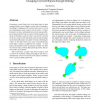Free Online Productivity Tools
i2Speak
i2Symbol
i2OCR
iTex2Img
iWeb2Print
iWeb2Shot
i2Type
iPdf2Split
iPdf2Merge
i2Bopomofo
i2Arabic
i2Style
i2Image
i2PDF
iLatex2Rtf
Sci2ools
ICRA
2000
IEEE
2000
IEEE
Grasping Curved Objects through Rolling
Grasping a curved object free in the plane may be done through rolling a pair of fingers on the object’s boundary. Each finger is equipped with a tactile sensor able to record any instantaneous point contact with the object. Contact kinematics reveal a relationship between the amount of finger rotations and the total curvatures of the boundary segments of the fingers and the object respectively traversed by the two contact points during the same period of rolling. Such relationship makes it possible to localize both fingers relative to the object from a few pairs of simultaneously taken finger contacts at different time instants. A least squares formulation of this localization problem can then be solved by the Levenberg-Marquardt algorithm. Simulation results are presented. After localization, a simple open loop strategy is used to control the continual rolling of the fingers until they simultaneously reach two locations on the object’s boundary where a grasp is finally p...
| Added | 31 Jul 2010 |
| Updated | 31 Jul 2010 |
| Type | Conference |
| Year | 2000 |
| Where | ICRA |
| Authors | Yan-Bin Jia |
Comments (0)

